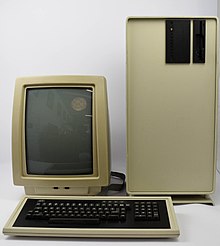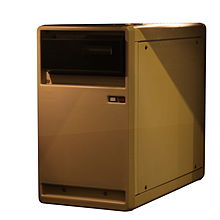 | |
| Developer | ETH Zurich |
|---|---|
| Manufacturer | Modula Computer Systems |
| Product family | Wirth |
| Type | workstation |
| Release date | 1980 |
| Introductory price | $8000 |
| Discontinued | Yes |
| Units sold | 120[1] |
| Units shipped | 120 |
| Media | Floppy disk 5.25 in (13.3 cm) 140 K |
| Operating system | Medos-2 (Modula-2) |
| CPU | AMD 2901 |
| Memory | 256 K (131,072 16-bit words) |
| Storage | 15 MB hard disk |
| Display | 12 in (30 cm) monochrome bitmapped |
| Dimensions | 15.5 in × 15 in × 14.5 in (39 cm × 38 cm × 37 cm) |
| Marketing target | Research |
| Successor | Ceres |


The DISER Lilith is a custom built workstation computer based on the Advanced Micro Devices (AMD) 2901 bit slicing processor, created by a group led by Niklaus Wirth at ETH Zurich.[2][3] The project began in 1977, and by 1984 several hundred workstations were in use. It has a high resolution full page portrait oriented cathode-ray tube display, a mouse, a laser printer interface, and a computer networking interface. Its software is written fully in Modula-2 and includes a relational database program named Lidas.
The Lilith processor architecture is a stack machine.[2] Citing from Sven Erik Knudsen's contribution to "The Art of Simplicity": "Lilith's clock speed was around 7 MHz and enabled Lilith to execute between 1 and 2 million instructions (called M-code) per second. (...) Initially, the main memory was planned to have 65,536 16-bit words memory, but soon after its first version, it was enlarged to twice that capacity. For regular Modula-2 programs however, only the initial 65,536 words were usable for storage of variables."[4]
- ^ ETH Zurich: Ready. YouTube (video). Zürich, Switzerland: ETH Zurich. 15 June 2017. Event occurs at 1:25–1:35. Archived from the original on 21 December 2021. Retrieved 21 March 2021.
- ^ a b Ohran, Richard (August 1984). "Lilith and Modula-2: A case study of high-level-language processor design". Byte. pp. 181–192. Retrieved 6 March 2021. Reprint.
- ^ Sand, Paul A. (September 1984). "The Lilith Personal Computer". Byte. pp. 300–311. Retrieved 6 March 2021. Reprint.
- ^ Böszörményi, László; Gutknecht, Jürg; Pomberger, Gustav, eds. (25 October 2000). The School of Niklaus Wirth: The Art of Simplicity. Morgan Kaufmann. ISBN 978-1558607231. ISBN 1-55860-723-4 & dpunkt, ISBN 3-932588-85-1.